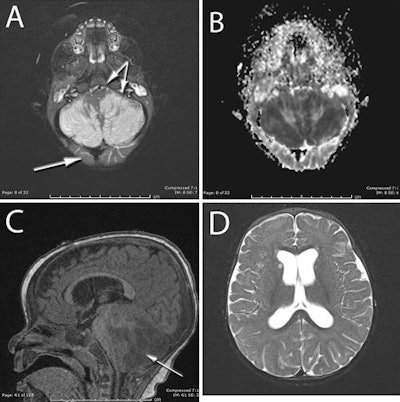
If there is any doubt that MRI can be a fast and effective lifesaving modality, a report published online August 15 in the Journal of Neurosurgery: Pediatrics offers the case of a 10-month-old baby girl who is alive today after accidentally ingesting the drug ketamine.
MR images revealed severe swelling in the child's cerebellar hemispheres but no damage to the upper part of her brain soon after she was found unresponsive and barely breathing. That's the reverse of what usually happens in cases of oxygen deprivation, leading quick-thinking pediatric emergency physicians and neurosurgeons to look for another cause.
The care team correctly suspected that a drug may have contributed to the child's situation, eventually discovering that she had accidentally been exposed to ketamine (J Neurosurg Pediatr, August 15, 2017).
The lesson to be learned from the case study goes beyond the accurate interpretation of MR images and improving a patient's condition, according to the researchers. They assert that the larger issue is escalating drug use in the U.S. and how it affects innocent people.
Recreational abuse
When administered properly, ketamine is given to adults and children for sedation and anesthesia. However, it is abused by recreational drug users who want to experience the drug's euphoric high and dissociative side effects. A ketamine overdose can lead to death, either due to the drug itself or risky behavior by users in the drug-induced mental state.
The saga described in the case study began when the baby vomited after eating eggs and before going down for a nap. Soon thereafter, she, her brother, and her grandmother were found unresponsive by a family member.
Initially, emergency rescue personnel suspected carbon monoxide was the cause. However, police eventually discovered that the trio had eaten from dishes used to soak tobacco leaves in ketamine for a recreational drug known as Kommon.
The baby was taken to the hospital's emergency room, where she was minimally responsive. Clinicians began her care with intubation and ventilation to improve her poor breathing.
An MRI scan then showed severe swelling in the cerebellar hemispheres, which blocked the normal flow of cerebrospinal fluid. The MR images showed no damage to the upper part of the baby's brain.
 MR images show severe swelling in the cerebellar hemispheres in a 10-month-old baby who accidentally ingested the drug ketamine. Images courtesy of the Journal of Neurosurgery: Pediatrics.
MR images show severe swelling in the cerebellar hemispheres in a 10-month-old baby who accidentally ingested the drug ketamine. Images courtesy of the Journal of Neurosurgery: Pediatrics.The researchers noted that the MRI results were unusual because in most cases, the upper part of a person's brain is damaged from a lack of oxygen and the cerebellum is spared. This reversal of common findings suggested a specific association with ketamine.
Given this information, clinicians inserted a drain in the baby's brain to divert the spinal fluid, and they used surgical decompression to make room for the swelling and to reduce the pressure on the brain.
Slowly, the child's neurological condition began to improve and she was taken off artificial ventilation six days after the operation. Two weeks later, the baby was able to participate in rehabilitation exercises, and the external ventricular drain was replaced with a cerebrospinal fluid shunt.
Six months after the incident and despite MR images showing permanent damage to the cerebellum, the child has achieved anticipated developmental milestones and normal muscle coordination, but with a slight delay in speech progression.
"We are very excited that the child has recovered well following this life-threatening event," said corresponding author Dr. Daniel Fulkerson from the department of neurological surgery and division of pediatric surgery at Indiana University Health. "Unfortunately, we fear that cases like this will continue to occur, as we have seen a dangerous rise in drug use in our state and in the nation. Innocent kids are often affected. We hope this case shines some light on this particular exposure and helps other medical facilities recognize these unique findings."


.fFmgij6Hin.png?auto=compress%2Cformat&fit=crop&h=100&q=70&w=100)





.fFmgij6Hin.png?auto=compress%2Cformat&fit=crop&h=167&q=70&w=250)











